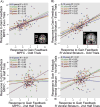Internal Consistency of Functional Magnetic Resonance Imaging and Electroencephalography Measures of Reward in Late Childhood and Early Adolescence
- PMID: 29057369
- PMCID: PMC5647886
- DOI: 10.1016/j.bpsc.2016.12.004
Internal Consistency of Functional Magnetic Resonance Imaging and Electroencephalography Measures of Reward in Late Childhood and Early Adolescence
Abstract
Background: Abnormal neural response to reward is increasingly thought to function as a biological correlate of emerging psychopathology during adolescence. However, this view assumes such responses have good psychometric properties-especially internal consistency-an assumption that is rarely tested.
Methods: Internal consistency (i.e., spilt-half reliability) was calculated for event-related potentials (ERPs) and Blood Oxygen Level Dependent (BOLD) responses to monetary gain and loss feedback from the same sample of 8-14 year-old females (n=177). Internal consistency for ERPs (i.e. feedback negativity) and BOLD responses within the ventral striatum and medial/lateral prefrontal cortex to gain, loss, difference scores (gain-loss), and residual scores (gain controlling for loss) were compared. Moderation analyses were conducted to investigate whether internal consistency differed by age.
Results: ERP and BOLD responses to gain and loss feedback showed high internal consistency in all regions (Spearman Brown Coefficients (SB) ≥ 0.70). When considering difference and residual scores, however, responses showed lower internal consistency (SBs ≤ 0.50), with particularly low internal consistency for subtraction-based scores (SB ≤ 0.36). Age was not a significant moderator of split-half relationships, indicating similar internal consistency across late childhood to early adolescence.
Conclusions: Within the same subjects, high internal consistency was observed for both ERP and fMRI measures of response to gains and losses, which did not vary as a function of age. Moreover, excellent psychometric properties were evident even within the first half of the experiment. Difference scores were characterized by lower internal consistency, although regression-based approaches outperformed subtraction-based difference scores.
Keywords: Adolescence; Childhood; ERP; Internal consistency; Reward; fMRI.
Conflict of interest statement
DISCLOSURES All authors report no biomedical financial interests or potential conflicts of interest.
Figures


Similar articles
-
Psychometric properties of neural responses to monetary and social rewards across development.Int J Psychophysiol. 2018 Oct;132(Pt B):311-322. doi: 10.1016/j.ijpsycho.2018.01.011. Epub 2018 May 7. Int J Psychophysiol. 2018. PMID: 29402529
-
A longitudinal examination of event-related potentials sensitive to monetary reward and loss feedback from late childhood to middle adolescence.Int J Psychophysiol. 2018 Oct;132(Pt B):323-330. doi: 10.1016/j.ijpsycho.2017.11.001. Epub 2017 Nov 4. Int J Psychophysiol. 2018. PMID: 29113953 Free PMC article.
-
Evaluating the internal consistency of subtraction-based and residualized difference scores: Considerations for psychometric reliability analyses of event-related potentials.Psychophysiology. 2021 Apr;58(4):e13762. doi: 10.1111/psyp.13762. Epub 2021 Jan 21. Psychophysiology. 2021. PMID: 33475156
-
Data quality and reliability metrics for event-related potentials (ERPs): The utility of subject-level reliability.Int J Psychophysiol. 2021 Jul;165:121-136. doi: 10.1016/j.ijpsycho.2021.04.004. Epub 2021 Apr 24. Int J Psychophysiol. 2021. PMID: 33901510 Review.
-
Neuroimaging and neuromodulation approaches to study eating behavior and prevent and treat eating disorders and obesity.Neuroimage Clin. 2015 Mar 24;8:1-31. doi: 10.1016/j.nicl.2015.03.016. eCollection 2015. Neuroimage Clin. 2015. PMID: 26110109 Free PMC article. Review.
Cited by
-
Reward-Related Neural Predictors and Mechanisms of Symptom Change in Cognitive Behavioral Therapy for Depressed Adolescent Girls.Biol Psychiatry Cogn Neurosci Neuroimaging. 2021 Jan;6(1):39-49. doi: 10.1016/j.bpsc.2020.07.010. Epub 2020 Jul 23. Biol Psychiatry Cogn Neurosci Neuroimaging. 2021. PMID: 32948509 Free PMC article.
-
Neuroimaging Biomarkers in Addiction.medRxiv [Preprint]. 2024 Sep 3:2024.09.02.24312084. doi: 10.1101/2024.09.02.24312084. medRxiv. 2024. PMID: 39281741 Free PMC article. Preprint.
-
The psychometric properties and clinical utility of neural measures of reward processing.Soc Cogn Affect Neurosci. 2023 Mar 25;18(1):nsad007. doi: 10.1093/scan/nsad007. Soc Cogn Affect Neurosci. 2023. PMID: 36961734 Free PMC article.
-
Blunted Neural Reward Responsiveness in Children with Recent Suicidal Ideation.Clin Psychol Sci. 2019 Sep;7(5):958-968. doi: 10.1177/2167702619856341. Epub 2019 Jul 9. Clin Psychol Sci. 2019. PMID: 32042508 Free PMC article.
-
Stability, change, and reliable individual differences in electroencephalography measures: A lifespan perspective on progress and opportunities.Neuroimage. 2023 Jul 15;275:120116. doi: 10.1016/j.neuroimage.2023.120116. Epub 2023 May 9. Neuroimage. 2023. PMID: 37169118 Free PMC article. Review.
References
-
- Insel T, Cuthbert B, Garvey M, Heinssen R, Pine DS, Quinn K, et al. Research domain criteria (RDoC): toward a new classification framework for research on mental disorders. The American journal of psychiatry. 2010;167:748–751. - PubMed
-
- Lilienfeld SO. The Research Domain Criteria (RDoC): an analysis of methodological and conceptual challenges. Behaviour research and therapy. 2014;62:129–139. - PubMed
-
- Cronbach LJ, Meehl PE. Construct validity in psychological tests. Psychological bulletin. 1955;52:281–302. - PubMed
-
- Meehl PE. Causes and effects of my disturbing little book. Journal of personality assessment. 1986;50:370–375. - PubMed
-
- Nelson BD, Perlman G, Klein DN, Kotov R, Hajcak G. Blunted Neural Response to Rewards Prospectively Predicts the Development of Depression in Adolescent Girls. American Journal of Psychiatry 2016 - PubMed
Grants and funding
LinkOut - more resources
Full Text Sources
Other Literature Sources
